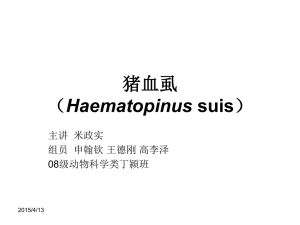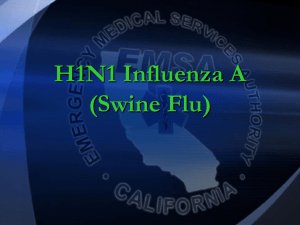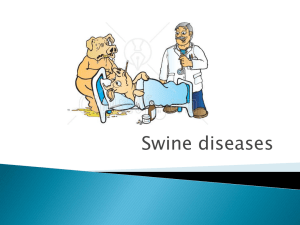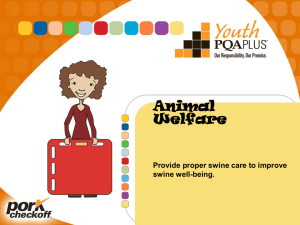Swine Flu Presentation
advertisement
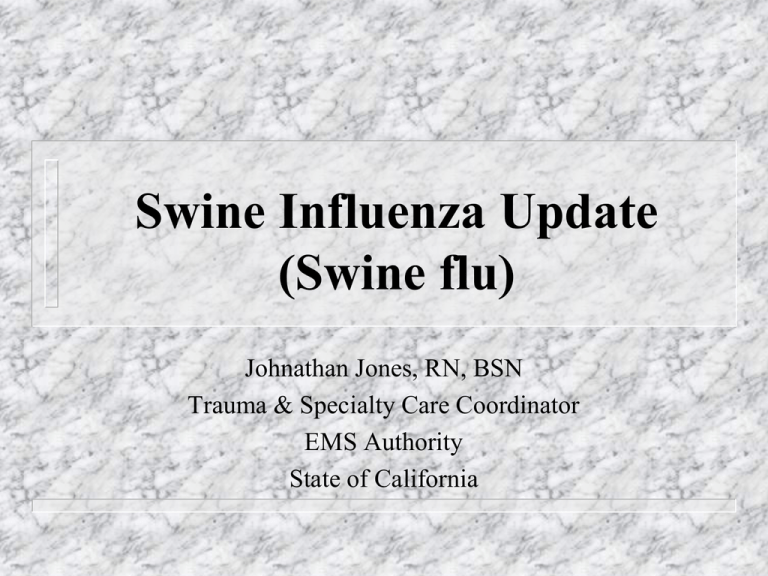
Swine Influenza Update (Swine flu) Johnathan Jones, RN, BSN Trauma & Specialty Care Coordinator EMS Authority State of California What is Swine Influenza (Swine flu)? Swine Influenza is typically a respiratory disease of pigs Swine flu has expanded to human-to-human transmission Swine flu is a type of: – Influenza-Like Illness (ILI) What is the current Status? Centers for Disease Control (CDC) has confirmed seven (7) cases of Swine Influenza in CA caused by swine influenza (H1N1) viruses Viruses contain a unique combination of gene segments that have not been reported previously among swine or human influenza viruses in United States Where is the Incidence Swine Flu? According to the CDC as of April 27, 2009 documented human-tohuman transmission of swine flu have now occurred in: – – – – – – – California Texas Ohio New York Mexico Eastern Canada New Zealand What is happening nationally with swine flu? According to the CDC as of April 27, 2009, of the confirmed cases of swine influenza A (H1N1) virus infection – – Only two confirmed case-patients were hospitalized None have died in the United States. What is happening internationally with swine flu? Mexican health officials have reported several hundred suspect cases, including several deaths associated with confirmed swine influenza A (H1N1) virus infection. In Mexico, many patients have experienced rapidly progressive pneumonia, respiratory failure requiring mechanical ventilation & acute respiratory distress syndrome (ARDS) Comparison of Cases Therefore, the experience of these two countries has been markedly different to date Getting better information to explain these differences is a high priority for the ongoing investigation What is a good way to get realtime information? News services are in the business to sensationalize & caution should be taken with all information The Centers for Disease Control (CDC) has created a page for daily update What are the symptoms of swine flu in humans? The symptoms of swine flu in people are expected to be similar to the symptoms of regular human seasonal influenza & include: – – – fever (greater than 100.0º F or 37.8 º C), AND cough & sore throat lack of appetite Internationally, some people with swine flu also have reported runny nose, nausea, vomiting, & diarrhea How can human infections with swine influenza be diagnosed? To diagnose swine influenza A infection – – – A respiratory specimen would generally need to be collected within the first 4 to 5 days of illness (when an infected person is most likely to be shedding virus) Some persons, especially children, may shed virus for 10 days or longer Identification as a swine flu influenza A virus requires sending the specimen to a laboratory for testing. Is the H1N1 swine flu virus the same as human H1N1 viruses? No, H1N1 swine flu viruses are antigenically very different from human H1N1 viruses Vaccines for human seasonal flu do not provide protection from this H1N1 set of swine flu viruses How does swine flu spread? Human-to-human transmission of swine flu predominantly occurs through direct droplet transmission This is thought to occur in the same way as seasonal flu, which is mainly person-to-person transmission through coughing or sneezing of infected people People may become infected by touching something with flu viruses on it & then touching their mouth or nose (moist mucous membranes). What should I do if I think I may be sick? Stay home & reduce the spread of infectious diseases Utilize barrier protection Utilize personal protective equipment (PPE) How can I limit the spread of contact transmission? Good hand hygiene or hand washing Create a barrier between yourself and the virus Remove the virus whenever possible through good cleansing of surfaces What is a barrier? The first barrier is distance – – If you are sick, stay home If you suspect someone of having the virus then protect yourself with person protective equipment (PPE) prior to entering their 6 foot radius. What is person protective equipment (PPE)? Personal protective equipment, commonly referred to as "PPE", is equipment worn to minimize exposure to a variety of hazards What is PPE for medical providers regarding droplet precautions? Wear a fit-tested N95 respirator, disposable gloves, gown, & eye protection (face shield or goggles) Place a surgical mask on the patient & utilize devices to reduce secretion distribution Before & after contact with respiratory infected people: – clean hands thoroughly with soap & water or an alcohol-based hand gel. What is good hand hygiene? Washing hand for more than 15 seconds with soap & water or apply an alcohol-based cleanser rubbing hands until dry When should you wash your hands with soap & water? Wash your hands with plain soap & water or with antimicrobial soap & water if: your hands are visibly soiled (dirty) hands are visibly contaminated with blood or body fluids hands come in contact with respiratory secretions before eating after using the restroom Are alcohol-based handrubs effective? More than 20 published studies have shown that alcohol-based handrubs are more effective than either plain soap or antibacterial soaps in reducing the number of live bacteria on the hands Won’t frequent use of alcohol dry out my skin? No! In fact, studies have proven that nurses who routinely cleaned their hands between patients by using a modern alcohol-based handrub had less skin irritation and dryness than nurses who washed their hands with soap and water Modern alcohol-based handrubs contain skin conditioners (emollients) that help prevent the drying effects of alcohol Do I need a prescription for hand cleansers? Most over-thecounter skin cleansers will remove bacteria and viruses if used as directed What medications are available to treat swine flu infections in humans? At this time, CDC recommends the use of : – – – Tamiflu (oseltamivir phosphate) or Relenza (zanamivir) As part of the treatment &/or reduction of severity of infection with swine influenza viruses More information on treatment recommendations can be found at: www.cdc.gov/flu/swine/recommendations.htm Is there a vaccine for swine flu? There is no vaccine to protect humans from swine flu at this time How can I reduce the spread of infectious diseases? Good hand washing Universal precautions at all times Respiratory droplet precautions – When an airborne illness is suspected


